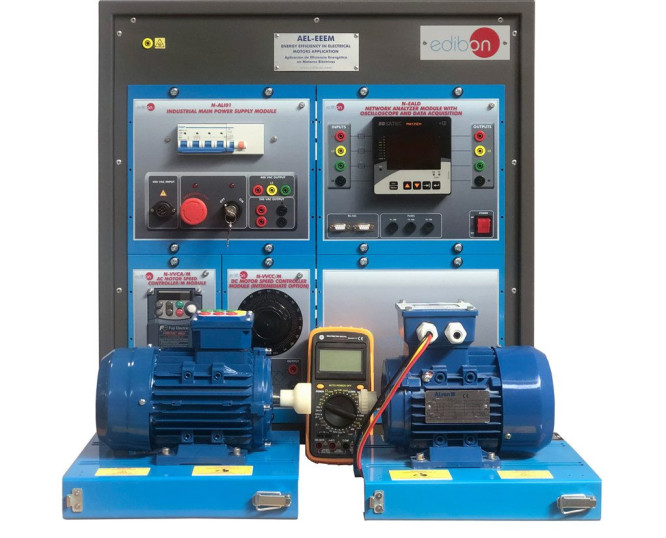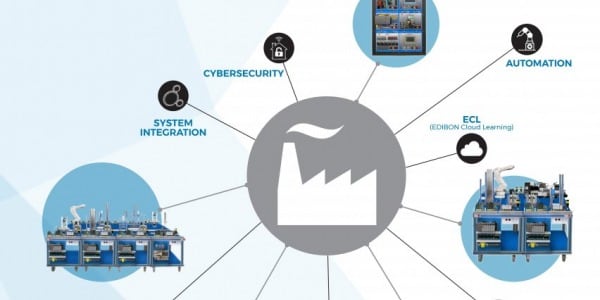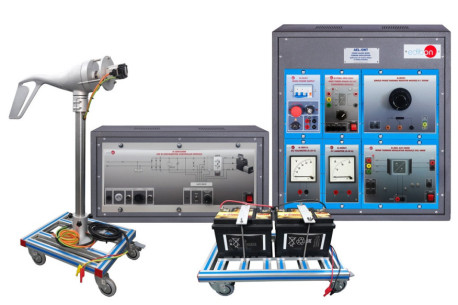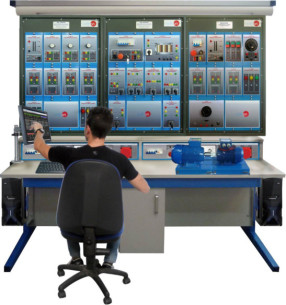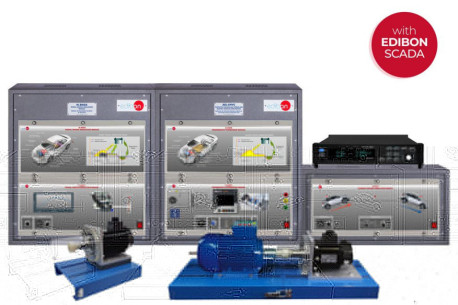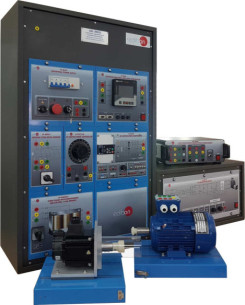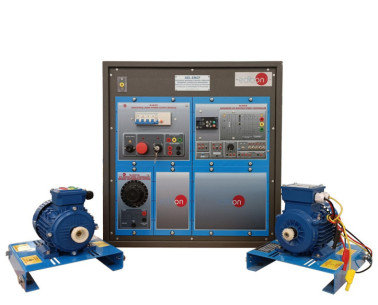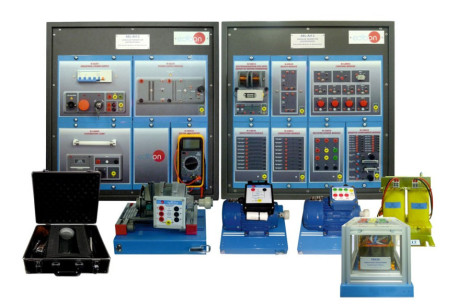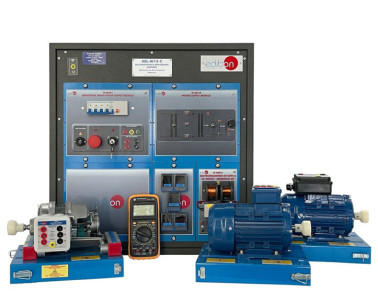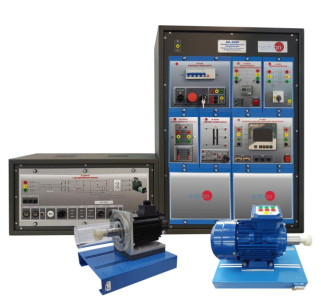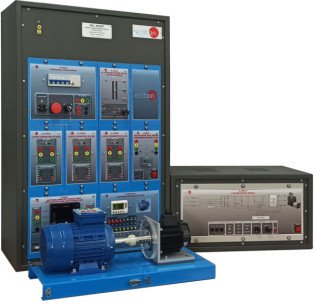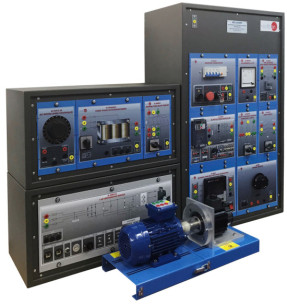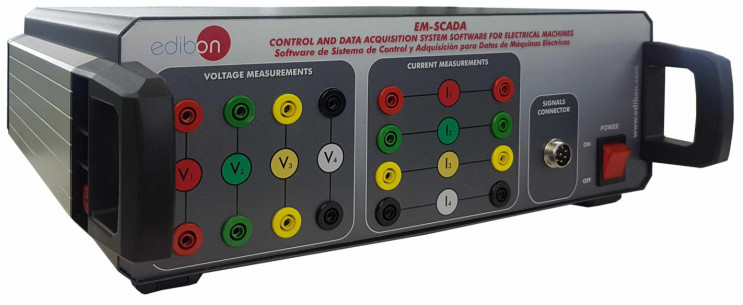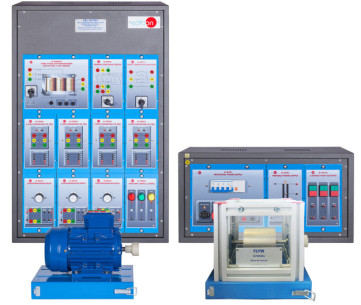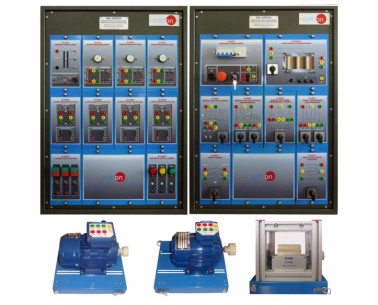Today we are at the beginning of a new era, named ‘Industrie 4.0’. Let´s explain a little further the concept "Industrie 4.0"!
AEL-EEEM Energy Efficiency in Electrical Motors Application
INNOVATIVE SYSTEMS
The Energy Efficiency in Electrical Motors Application, "AEL-EEEM" has been designed by EDIBON to allow the students to understand how cutting-edge devices used in high performance systems to control electrical motors work: frequency controllers versus conventional electrical power.
RELATED NEWS
General Description
The Energy Efficiency in Electrical Motors Application, "AEL-EEEM" has been designed by EDIBON to allow the students to understand how cutting-edge devices used in high performance systems to control electrical motors work : frequency controllers versus conventional electrical power.
Actual frequency controllers can automatically control (PID) the speed of the motors depending on different conditions, such as loads variations in the motor´s shaft. In the "AEL-EEEM" application allows controlling different loads conditions through the Eddy Current Brake, "FRECP". The results can be analyzed thanks to an included network analyzer which shows the most important electric parameters. The AEL-EEEM shows how to program the frequency controller to get an optimal consumption depending on the braking load.
Exercises and guided practices
GUIDED PRACTICAL EXERCISES INCLUDED IN THE MANUAL
- Wiring an Asynchronous Three-Phase Motor of Squirrel Cage.
- Start-up of the frequency controller.
- Forward and reverse operations with the induction motor and the frequency controller.
- Comparison of the energy consumption by the conventional electrical power and the frequency controller.
- Programming of the frequency controller according to different electrical machines operations.
- Checking the behavior of the electrical machine in function of the braking torque.
- Study the motor functioning for a demand instruction.
- Programming of the frequency controller for different loads.
- Programming of the frequency controller to get an optimal consumption.
- Analyze the electrical parameters.
SIMILAR UNITS AVAILABLE
5.3.3.- WIND ENERGY
AEL-SWT
The Stand-Alone Wind Turbine Aplication, "AEL-SWT", has been designed by Edibon for the training at both the theoretical and practicallevels in the field of wind turbines.The "AEL-SWT" application provides several levels of training to give the...
SUPPLEMENTARY EQUIPMENT
2.5.- AUTOMOTIVE ELECTRONICS
AEL-EHVC
Computer Controlled Hybrid and Electric Vehicles Application
The Computer Controlled Hybrid and Electric Vehicles Application, "AEL-EHVC", is an application designed by EDIBON for the theoretical and practical training of the different topologies of electric/hybrid vehicles most used today.Given the...
4.3.2.1.- AC ELECTRICAL MOTORS AND GENERATORS
AEL-EMSS
Electrical Machines Soft Starters Application
The Electrical Machines Soft Starters Application, "AEL-EMSS", has been designed by EDIBON to instruct the student in managing soft-starters of three-phase electrical machines. This application basically consists of three types of optional...
4.3.2.1.- AC ELECTRICAL MOTORS AND GENERATORS
AEL-EMCF
Electrical Machines Control through Frequency Controller Application
The Electrical Machines Control through Frequency Controller Application, "AEL-EMCF", has been designed by EDIBON to instruct the student in managing of frequency controllers for the control of three phase induction electrical machines.This...
4.3.2.1.- AC ELECTRICAL MOTORS AND GENERATORS
AEL-AI13
Electrotechnics Application (RLC Circuits, Electrostatics, Motors, Transformers, Lighting)
The Electrotechnics Application (RLC Circuits, Electrostatics, Motors, Transformers, Lighting), "AEL-AI13", designed by EDIBON to study the basic knowledge about electric engineering.The application teaches the student several topics like electric...
4.3.2.1.- AC ELECTRICAL MOTORS AND GENERATORS
AEL-AI13-C
Electrotechnics Application (Motors)
The Electrotechnics Application (Motors), "AEL-AI13-C", has been designed by EDIBON to study different motor types: single-phase induction motor with starting and running capacitor, universal motor, three-phase squirrel cage induction motor.This...
4.3.2.1.- AC ELECTRICAL MOTORS AND GENERATORS
AEL-EMRP
Electrical Machines Relays Protection Application
The Electrical Machines Relays Protection Unit, "AEL-EMRP" has been designed by EDIBON to study the elementary protections for three phase squirrel cage induction motors.In order to study the behavior of the electrical machines protections, this...
4.3.2.1.- AC ELECTRICAL MOTORS AND GENERATORS
AEL-MMRT
Motor Management Relays Application
The Motor Management Relays Application, "AEL-MMRT", has been designed by EDIBON in order to study the behavior of three-phase induction motors when they are managed with a PLC.This application allows the students learning the main operations and...
4.3.2.1.- AC ELECTRICAL MOTORS AND GENERATORS
AEL-ACEMT
Advanced AC Electrical Motors Application
The Advanced AC Electrical Motors Application, "AEL-ACEMT", has been designed by Edibon to carry out electrical/mechanical test for a great variety of AC motors. Such tests allow obtaining the most significant electrical and mechanical...
4.3.2.2.- DC ELECTRICAL MOTORS AND GENERATORS
EM-SCADA
Control and Data Acquisition System Software for Electrical Machines
The Control and Data Acquisition System Software for Electrical Machines, "EM-SCADA", has been developed by EDIBON to study and analyze the performance of rotating and static electrical machines such as three-phase and single-phase AC motors,...
4.3.2.1.- AC ELECTRICAL MOTORS AND GENERATORS
AEL-ACINA
Application of AC Three-Phase Induction Motor of Squirrel Cage
The Application of AC Three-Phase Induction Motor of Squirrel Cage, "AEL-ACINA", is designed for the study of the main operations performed in the industrial field with three-phase squirrel cage induction motors. The student will learn the most...
4.3.2.1.- AC ELECTRICAL MOTORS AND GENERATORS
AEL-ACDHA
Application of AC Dahlander Three-Phase Induction Motor
The Application of AC Dahlander Three-Phase Induction Motor, "AEL-ACDHA", is designed for the study of the main operations performed in the industrial field with dahlander electrical motors.The student will learn the most important operations of...
Quality

AFTER-SALES SERVICE

 Cookie preferences
Cookie preferences

